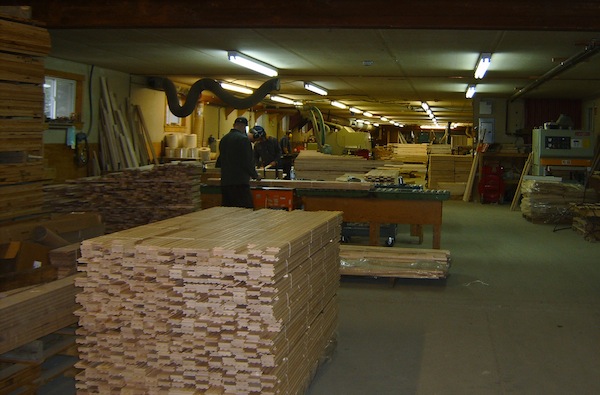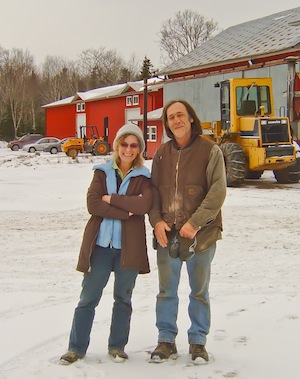
From the highway, a short snowy tree-lined road quickly opens up to the mill and offices for Finewood Flooring. The Christianos are busy at work when I arrive half an hour early. “People always think we’re way out there,” Candace Christiano tells to me with a laugh. “But we’re only twenty minutes from Baddeck!”
As we sit down in the cosy office for Finewood Flooring, Candace Christiano shows me a magazine article from the ‘70s, written about the young couple who had recently immigrated from New England. At that time, land was unaffordable in their southern home, so the Christianos followed the coast north, to see what else was out there.
In Cape Breton they found affordable land, but the young couple wasn’t sure if that could make a full-time living here. However, the industrious pair soon found a way to do it, and they set to work building their home and business in Middle River. Now 30 years later, the Christianos employ about 10 people from the local community, who help them manufacture tongue and groove hardwood flooring boards. As we tour the mill, Candace tells me it was a fairly steady and natural progression from their early beginnings in carpentry and woodworking. As new machinery was acquired, they were able to evolve the business. A strong appetite in the European market for maple flooring has really helped the business flourish.
At Finewood Flooring, all the wood that comes to the facility gets used. Rough cut boards are sorted into various products based on imperfections and the quality of the wood. If a slit in the board prevents it becoming 5 inch wide plank floor board, then it is marked and cut into smaller size flooring. What isn’t used in production, the scraps and waste, is pelletized and used to heat the manufacturing building, or sold as pellets. The Christianos see their value-added product as being an efficient use of local resources. Not only are they reusing the by-product, but they are also saving the cost of shipping that material by exporting a finished product rather than raw materials. Finewood Flooring products are certified by the Forest Stewardship Council as having come from healthy forests where forests, wildlife, waterways and the rights of local communities are conserved.
Having come from an area that had a well-developed economy for value added wood products, the Christianos were surprised to see how under-utilized hardwood timber was in their new home province. They can now point to a few major barriers that contribute to this situation. For starters, they had to prove to many people that there actually could be a hardwood industry in Nova Scotia. Peter Christiano explains that the timber economy that has established here, is actually suited to a forest type that is in transition. The mills and timber grants are set up to harvest softwood conifer trees which are more common to the boreal forests of the North, but which have become prevalent here as farmsteads are reclaimed and the forest transitions back into mature Acadian forest. The infrastructure and timber leases for Crown land are based on the softwood industry and access to the hardwood components and the infrastructure needed to sustainably harvest those resources, are still not readily available.

Despite the positive accolades coming their way, this forward-looking couple still see serious challenges ahead for their community and the hardwood industry. Though forestry practices and conditions seem to be slowly improving, the Christianos deal with the same problems facing the region at large. When I visited, they had just lost an employee to the Tar Sands of Alberta. How to create an environment where people can thrive and live sustainably in rural Cape Breton communities is an issue always close at hand, even while standing in the middle of a good living model for sustainable local enterprise.
The Christianos believe that there is so much that could be done to create a more vibrant industry and community. From creating more value-added wood products and services to establishing family-friendly forest trails that provide opportunities for learning about our forests and developing an appreciation for what they provide us with.
After a healthy discussion about current affairs, and trying our best to get to the bottom of what’s wrong with the world, the Christianos and I decide to close the book for another day. Shaking hands with these fine folks, I am grateful that they didn’t heed the advice from the one piece of hate mail they received, following publication of the 1970’s magazine article. That of course being along the lines of: “Go back where you came from, draft dodgers! We don’t need you ‘round these parts!” How far from the truth! So let us not be quick to judge hitchhiking forest dwellers like Sam. For, like the Christianos, he’ll probably be able to teach us a thing or two about sustainability.

